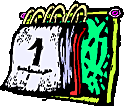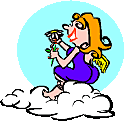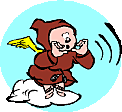

Rabboisai,
There is a famous Maiseh Shehoya about RASHI Hakoidesh. One day,
RASHI decided that he wanted to know who his chavrusa would be in
Oilum Habah. So he prayed to the Reboinoisheloilum for seven days.
In the evening of the seventh day RASHI fell into a deep sleep. That
night, the Aimishteh came to him and related the name and location
of his future study partner. RASHI woke up excitedly the following
morning. Immediately after breakfast, he set out on a journey across
Europe, beginning at his home in France, passing through Italy and
what is today Austria and Hungary, and arriving in Romania in a city
called Brasov; in all, a voyage of three weeks by horse and
carriage. Upon his arrival in the town, RASHI began to look for his
future study partner.
He first went to all the Bussay Medrish, but no one had ever heard
the name of the man RASHI asked about. Then he went to the local
shuls. Again, no one had heard of the person. Finally, he checked
into a lodge to stay overnight, and on a whim, asked the matron of
the lodge if she knew the man that RASHI was seeking. Yes, she
replied, she knew the man very well. She told RASHI that he could be
found at a local stable. Excited, RASHI hurried off to meet his
future chavrusa, only to discover that the man spent his days
cleaning the stalls of the animals.
Highly distraught, RASHI had a dream that night where he came face
to face with Hakadoshboruchhu. "Why did you give me such a mediocre
chavrusa?" RASHI complained. "I am the great RASHI, interpreter of
Toirah for generations of Klal Yisroel, and I should be partnered in
Oilum Habah with a stable boy?!"
The Reboinoisheloilum responded. "You are indeed the great RASHI,
the greatest commentator in all of the Yiddishe Velt, and who is
sought regularly by scores of Jewish men. But the stable boy is hung
like a horse, and is sought out regularly by Jewish women. You will
make a great team."
Rabboisai, I share this story with you because, as you know, we are
not all created the same. Some are taller and some are shorter. Some
are smarter, and some are dumber than an overcooked kishka. Some are
attractive, and some look like the fungus on the bottom of Oig
Melech Habashan's oversized foot. But together we make up the
community that is Klal Yisroel.
But does this mean that we should all be treated as equals? Should
I, a great Toirah scholar have to pay the same amount of taxes as
you, you Am Haaretz? Should you, my beloved talmid, have to wait in
line for a movie on 84th street and Broadway the same amount of time
as a student at Yeshiva University, or, chass v'sholom, the same
amount of time as a student from the Jewish Theological Seminary?
These questions are similar to a discussion in a Gemarrah in Nidah,
where Abaya and Rava have a machloikess on why the Aimishteh created
women. According to Abaya, women were created to support man's basic
mission to work and procreate. They are to cook, clean, passively
perform maisay biyuh, and keep the damn children as far away from me
as possible when I am trying to get some work done on my laptop.
Abaya cites the pussuk where the Hakadoshboruchhu creates Chava as
Adam's Eizer Kinegdo, his "helpmate," out of Adam's rib (Bereishis,
Perek Baiz, Pussuk Chuff Aleph). Says Abaya, if women were intended
to be our equals, Chava would have been created out of a more
important body part, such as one of Adam's schvantzlach.
But Rava holds farkhert. He points to an earlier Pussuk – Bereishis,
Perek Aleph, Pussuk Chuff Zayin – as proof that man and woman were
created together, concurrently, and as such, are fundamentally
equals. He notes that in his home his wife pays the bills, makes the
bracha on the Shabbos challah, and likes to make mei raglayim while
standing.
So how is one to understand the complex nature of the role of women
within a Jewish context given the conflicting Toirah and Halachic
messages? How do we inform our attitudes and behavior from Toirah
perspectives that on one hand tell us that "Hakol Oilim Laminyan
Shivah, Afilu Isha"(Megillah, Chuff Gimmel), that every one may be
called to read from the Toirah, including a woman, but on the other
hand tell us that teaching women is the equivalent of Tiflus
(Soitah, Chuff)? What's pshat, for Reboinoisheloilum's sakes?
There are, of course, intense speculation and halachic prescriptions
on this topic by Chazal. Commenting on the notion of women not
reading from the Toirah due to "Kvoid Hatzibur," the Hai Goyn
suggests that the gemarrah was worried about a situation where a
maideleh is in Nidah on Shabbos Koidesh, chass v'sholom, and may
bleed all over the Bimah, dyeing the cloth carpet red on Shabbos,
resulting in an Issur Dioraisah of Tzovayah.
The RAN, however, holds that the concern of "Kvoid Hatzibur" relates
to the chashash that a woman, while reading from the Toirah, might
look up for a moment and be instantly attracted to the 60-ish,
overweight, bearded rabbi in the dark suit standing at the front of
the shul, and might not be able to control her animal-like urges.
This would cause the kehillah great discomfort, as they witness the
Baalas Koiray ripping off the rabbi's shirt to slowly stroke his
manly Arba Kanfois with her right hand, as she begins to loosen his
gartel with her left. Then she would twirl his payis in her fingers
while stroking his beard, and begin to whisper the leyning in his
ear… Errr… Well, I often worry about things like this when I am in
the front of my shul delivering a drasha…
Perhaps the halachic shakvetarya (discourse) is not the best source
for understanding the basic nature of the role of women as
envisioned in our heritage. Perhaps a better model may be viewed in
the Zoihar. The Zoihar understands that the Aimishteh can be viewed
the prisms of ten different Divine Aspects, the Sfirois. Rooted in
the Ein Soif, the indescribable hidden part of the
Reboinoisheloilum, the Sfirois emanate like a tree. The outermost
Sfirois are Yesoid, the foundation of Hakadoshboruchhu's activity in
the world, and Malchuss, His kingdom. Malchus is most commonly known
as the Shechinah.
According to the Zoihar, balance in the world was once maintained by
a constant unity between Yesoid, viewed as the male aspect of the
Aimishteh, and the Shechina, the female aspect. But from the time
that mankind gained self awareness, as personified by the casting
out of Adam Harishoin from Gan Eidan, Yesoid and Malchuss became
separated from one another. Yes, in the cosmic view of Yiddishkeit,
the natural, optimal state of male and female – man and woman – is
to be in a fundamental state of balance and unity.
So we must ask ourselves: How did this natural partnership between
male and female deteriorate into its current state?
According to Reb Moishe Chaim Luzzatto, man is to be blamed for the
decline of the role of woman, due to his insistence that his wife
should stop freaking nagging him already about what to get Shaindel
for her Bas Mitzvah. It's just a freaking party, for
Reboinoisheloilum's sakes, to which Shaindel's parents invited five
hundred of their closest friends.
But according to Reb Yoisaiph Gikatilla, the fault lies clearly with
woman, and is the result of women wearing shaytels that are two
sizes too tight.
The ARIZAHL agrees that the decline of the feminine aspect is the
fault of woman, but states that her withdrawal from cosmic
responsibility is the result of a complex organic process. Says the
ARIZAHL – every Jewish Maydel is born perfect. She grows up in a
Bayis Ne'eman B'Yisrael, maybe gets an education, chass v'sholom,
and then marries her chussin. The problem is that the typical Jewish
woman's brains are expelled from her body with her afterbirth. By
about the third child, a Jewish woman is pretty much like that
episode of Star Trek where Spock's brain gets taken out and Dr.
McCoy has to guide him using a remote control. According to the
ARIZAHL, in our generation, instead of a remote control, women are
guided the Bed, Bath, and Beyond catalogue and Botox.
I am reminded of an early occurrence in my marriage to my bashert,
Feige Breinah. We had conceived our first child, Baruch Hamavdil,
but had not yet reached the completion of the first trimester. We
agreed not to share news of the impending event to avoid an Ayin
Harah. Later that week, I was wished a Mazel Toiv by the shoeshine
boy's cleaning woman. I had not told a soul. Feigeleh swore she had
not either, but promised to find out who did. So she hired outside
consultants to investigate the source of the leak. After tracking
down various phone records, all signs pointed back to my mother-in-
law, may she rest in peace, soon. As it turns out, whenever she
visited our home, she would dip a pregnancy test in the toilet,
measuring hormone levels in the pish-vasser. Based on this, she
diagnosed my wife's pregnancy, as well as my bran deficiency.
However, two years later, when we conceived our fifth child, Feigeh
Breineh no longer cared about keeping the happy news secret. On the
contrary, she publicly celebrated as soon as she found out about her
pregnancy by ingesting a full bottle of sleeping pills.
So while man and woman begin their journeys through life with a
clear head and a clean slate, the years leave their impact. Only
very special people are able to maintain an optimal social and
spiritual balance over an extended period of time, typically people
that have a deep commitment to Toirah, an innate sense of their role
in the broader cosmic reality, or are hung like a horse.




